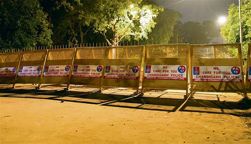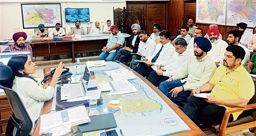Lalit Mohan
Tribune News Service
Dharamsala, March 20
Rock cut temples at Masroor in Kangra district are decaying fast. Carved out of a single sand rock, these are unique as they are on a rocky ridge whereas other temples in India are located below the surface. However, sand composition of rock which is prone to damage is also putting the structures at risk.
The temples are now under the protection of Archeological Survey of India (ASI). Though extenssive damage was caused to the temples after the 1905 earthquake in Kangra district, the ASI managed to restore many portions of the temples. Sources said the ASI protected the temples from weathering using some chemical treatment that hardens the sand rock and delays its decay due to rain and other factors. However, it has not proved to be that effective. At some places, even cement has been used to strengthen the temple structure.
Professor NK Singh, who has written a book on the temples, said international experts should be hired to protect the structures. He said the state should also come forward as it was part of the heritage of Himachal.
The rock cut temples located in Masroor have been an enigma for historians and archeologists. Even officials of the Archeological Survey of India, who are maintaining the site, are not sure about the history of temples.
Prof NK Singh’s book ‘Coronation of Shiva Rediscovering Masroor Temple’ has tried to resolve the mystery of the temples.
Masroor temples are one of the four monolithic rock cut temples in the country. Two of these, including Kailash of Ellora and Mamlapuram in Deccan, are quite famous. The third is Dhamnar in Rajasthan and the fourth in Kangra district. While the other three temples are in pits or on the ground, Masroor is unique as it is located on a hilltop at a height of about 2,500 feet.
According to a popular legend, the Masroor complex was built by Pandavas. However, Prof NK Singh’s book says the temples were built during the 6th-8th century AD. He has based his opinion on the fact that before this period, there was no evidence of rock cut temples in the country. After 8th century, there was chaos in the region and the rulers did not have resources or time to take up such huge projects.
He has studied various kings who ruled the area, including Harshvardhan, Yashoverdhan, Lalitaditya ruler of Kashmir, Jayapal and Prithvi Chand. By deliberating on the fact that the king who built the temple complex was a Lord Shiva devotee and had huge resources, NK Singh concluded that most likely it was Yashoverdhan who got the Masroor temples built. He has, however, said the issue was still open for research.
The temples’ entire theme of carvings revolves around festivity and coronation of Lord Shiva who is at the centre of all Gods and Goddesses.


























